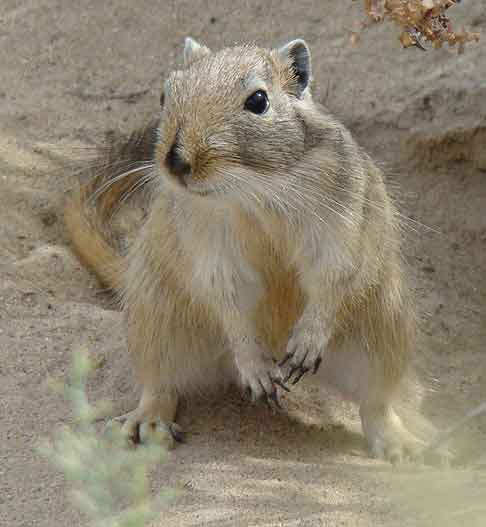
Rhombomys opimus (*)
Superregnum: Eukaryota
Cladus: Unikonta
Cladus: Opisthokonta
Cladus: Holozoa
Regnum: Animalia
Subregnum: Eumetazoa
Cladus: Bilateria
Cladus: Nephrozoa
Superphylum: Deuterostomia
Phylum: Chordata
Subphylum: Vertebrata
Infraphylum: Gnathostomata
Megaclassis: Osteichthyes
Cladus: Sarcopterygii
Cladus: Rhipidistia
Cladus: Tetrapodomorpha
Cladus: Eotetrapodiformes
Cladus: Elpistostegalia
Superclassis: Tetrapoda
Cladus: Reptiliomorpha
Cladus: Amniota
Cladus: Synapsida
Cladus: Eupelycosauria
Cladus: Sphenacodontia
Cladus: Sphenacodontoidea
Cladus: Therapsida
Cladus: Theriodontia
Cladus: Cynodontia
Cladus: Eucynodontia
Cladus: Probainognathia
Cladus: Prozostrodontia
Cladus: Mammaliaformes
Classis: Mammalia
Subclassis: Trechnotheria
Infraclassis: Zatheria
Supercohors: Theria
Cohors: Eutheria
Infraclassis: Placentalia
Cladus: Boreoeutheria
Superordo: Euarchontoglires
Ordo: Rodentia
Subordo: Myomorpha
Superfamilia: Muroidea
Familia: Muridae
Subfamilia: Gerbillinae
Genus: Rhombomys
Species: R. opimus
Name
Rhombomys opimus (Lichtenstein, 1823)
Synonyms
Meriones opimus Lichtenstein, 1823
References
Lichtenstein, 1823 Naturh. Anh. Eversmann's Reiser, p. 123
Links
Rhombomys opimus – Taxon details on Integrated Taxonomic Information System (ITIS).
IUCN: Rhombomys opimus (Least Concern)
English: great gerbil
polski: myszoskoczek wielki
The great gerbil (Rhombomys opimus) is a large rodent found throughout much of Central Asia.
Description
The largest of the gerbils, great gerbils have a head and body length of 15–20 cm (6–8 in). Their skulls are distinctive by having two grooves in each incisor. They have large front claws used for burrowing.[2]
Distribution and habitat
Great gerbils are found in arid habitats, predominantly in sandy or clay deserts. They are found in Turkmenistan, Kazakhstan, Mongolia, China, Pakistan, Afghanistan, and Iran.[1]
Predators
The great gerbil is preyed on by foxes, owls, kites, wildcats, weasels, vultures, and cobras.
Ecology and behavior
Great gerbils live in family groups and occupy one burrow per family.[3] Their burrows can be fairly extensive with separate chambers for nests and food storage. Great gerbils spend considerably more time in the burrows during winter, but do not hibernate. They are predominantly diurnal. Food consists mostly of vegetable matter.[2]
The animals are often colonial. Longevity is 2–4 years. Burrow system complexes have a distinctive region of cleared soil and can be seen and mapped from aerial photos and satellite images.[4] Inhabited great gerbil burrows can be distinguished from abandoned burrows using satellite images.[5]
Great gerbils are known reservoirs of Yersinia pestis, the bacterium that causes plague, and of Leishmania major, the causative agent of zoonotic cutaneous leishmaniasis. They are also known as crop pests and have been implicated in exacerbating erosion.
References
Shar, S.; Lkhagvasuren, D.; Molur, S. (2017) [errata version of 2016 assessment]. "Rhombomys opimus". IUCN Red List of Threatened Species. 2016: e.T19686A115153015. doi:10.2305/IUCN.UK.2016-3.RLTS.T19686A22446507.en. Retrieved 13 March 2022.
Smith, Andrew T.; Xie, Yan; Hoffmann, Robert S.; Lunde, Darrin; MacKinnon, John; Wilson, Don E.; Wozencraft, W. Chris (2010). A Guide to the Mammals of China. Princeton University Press. p. 251. ISBN 978-1-4008-3411-2.
Randall, J.A. (2005). "Flexible social structure of a desert rodent, Rhombomys opimus: philopatry, kinship, and ecological constraints". Behavioral Ecology. 16 (6): 961–973. doi:10.1093/beheco/ari078.
Wilschut, L.I.; Addink, E.A.; Heesterbeek, J.A.P.; Dubyanskiy, V.M.; Davis, S.A; Laudisoit, A.; Begon, M.; Burdelov, L.A.; Atshabar, B.B; de Jong, S.M. (2013). "Mapping the distribution of the main host for plague in a complex landscape in Kazakhstan: An object-based approach using SPOT-5 XS, Landsat 7 ETM+, SRTM and multiple Random Forests". International Journal of Applied Earth Observation and Geoinformation. 23 (100): 81–94. Bibcode:2013IJAEO..23...81W. doi:10.1016/j.jag.2012.11.007. PMC 4010295. PMID 24817838.
Wilschut, L.I; Heesterbeek, J.A.P.; Begon, M.; De Jong, S.M.; Ageyev, V.; Laudisoit, A.; Addink, E.A. (2018). "Detecting plague-host abundance from space: Using a spectral vegetation index to identify occupancy of great gerbil burrows". International Journal of Applied Earth Observation and Geoinformation. 64: 249–255. Bibcode:2018IJAEO..64..249W. doi:10.1016/j.jag.2017.09.013. PMC 5763245. PMID 29399006.
Nowak, R. M. (1999). Walker's Mammals of the World. Vol. 2. London: Johns Hopkins University Press.
Retrieved from "http://en.wikipedia.org/"
All text is available under the terms of the GNU Free Documentation License

